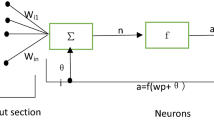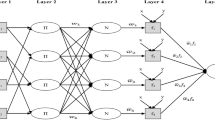Abstract
Thermal power plants are very important to a country’s energy, and dust is a major threat to the safety of thermal power plants. Over the past decade, dust explosion events of various degrees have emerged one after another, leading to serious respiratory disease, lung disease and even death. Therefore, the prediction of dust situation in coal mining face is helpful to take preventive measures in advance to ensure safety and has great significance for reducing dust hazards and avoiding coal dust accidents. The establishment of BP neural network model for the prediction of dust concentration of thermal power plant is practiced. The existing models lack the fitting ability of the algorithm and the inaccuracy of prediction. To address the challenges in the existing models, an improved genetic algorithm is proposed to improve the objective function. The proposed model is based on the optimal weight and threshold value. The threshold value is obtained by the improved genetic algorithm. The neural network prediction model is used to calculate the dust concentration of fully mechanized mining face. The new prediction model is compared with the common model and the standard BP neural network algorithm. The results show that the fitting ability and prediction accuracy of the neural network algorithm of the improved genetic algorithm are significantly improved.













Similar content being viewed by others
Data availability
Enquiries about data availability should be directed to the authors.
References
Ai HF, Shi Y (2015) Haze weather prediction based on BP artificial neural network. Comput Simul 32(1):402–405
Albayrak M, Allahverdi N (2011) Development a new mutation operator to solve the traveling salesman problem by aid of genetic algorithms. Expert Syst Appl 38(3):1313–1320
Ali MZ, Awad NH, Suganthan PN et al (2018) An improved class of real-coded genetic algorithms for numerical optimization. Neurocomputing 275:155–166
Chu Y, Cheng ZJ, Dong YS (2018) The hazards of dust environment in thermal power plants and their control countermeasures. Environ Dev 30(02):68–70
Du Y, Meng XC, Zhu LQ (2020) Genetic Algorithm and Neural Network overlapping spectral analysis. Spectrosc Spectr Anal 40(7):2066–2072
Feng R, Zhang HR, Shao HH (2002) Soft sensor modeling based on support vector machine. Inf Control 21(6):567–571
Guan JW, Liu ZX, Liu Y (2012) Comparative study on big data Layout and Application of Major Domestic and foreign Internet companies. China Media Sci Technol 17:45–49
Hu Y, Li J, Hong M et al (2019) Short term electric load forecasting model and its verification for process industrial enterprises based on hybrid GA-PSO-BPNN algorithm-A case study of papermaking process. Energy 170:1215–1227
Ji QQ, Wen HZ (2015) Research on big Data Platform architecture of Public Transportation. Electron Sci Technol 2:127–130
Leno IJ, Sankar SS, Ponnambalam S (2018) MIP model and elitist strategy hybrid GA-SA algorithm for layout design. J Intell Manuf 29(2):369–387
Li MW, Sha XY (2016) Improvement and application of grey prediction model. Comput Eng Appl 52(4):24–30
Liu SQ (2018) Analysis of dust causes and study on dust prevention measures of coal conveyance belt in thermal power plant. Technol Mark 25(04):136–137
Mokshin AV, Mokshin VV, Sharnin LM (2019) Adaptive genetic algorithms used to analyze behavior of complex system. Commun Nonlinear Sci Numer Simul 71:174–186
Ou L, Zhu J (2021) Dust origin and dust suppression measures power plant coal conveying system. J Shanghai Energy Conserv 02:190–193
Qiu WK (2019) Study on dust comprehensive control path of coal conveying system in thermal power plant. Econ Manag Digest 16:160–161
Ren YG, Niu XX, Ding KJ et al (2012) Statistical analysis and prediction of dust concentration in ambient air of Zhengzhou. Ind Saf Environ Protect 38(8):25–27
Su BG, Tian L, Wang Q, Liu JZ (2011) An Online soft measurement method for coal quality. Electr Power Sci Eng 07:32–36
Wang H, Song YP, Jiang QJ (1999) Distribution characteristics and control measures of boiler dust in coal-fired power plant. Sci Technol Inf Dev Econ 06:62–63
Wang SH, Lin YF, Yang YQ, Yan FC (2012) Soft measurement of coal mill primary air volume based on LSSVR. Electron World 2(14):73–75
Wang YH, Gao M, Zhao SB (2021) The establishment and application of mine dust concentration prediction model. China Min 30(01):178–181
Wen GJ, Dai LK, Liu W (2021) Quantitative analysis of mixture composition Raman spectroscopy based on genetic algorithm and linear superposition model. Chin J Anal Chem 49(1):85–94
Xu Z, Ni WC, Ji YH (2021) Rotating forest based on multi-peak genetic algorithm. J Cent South Univ 28(6):1747–1764
Xue XP, Zhang J (2017) Continuous monitoring technology for ultra-low emission of wet flue gas dust in thermal power plants. Shanxi Electron Technol 06:11–13
Zhang X, Wang W, Wang X (2002) Research of the particle size neural network soft sensor for concentration process. Control Theory Appl 19(1):85–88
Zhang RQ, Wang L, Xiao ZH et al (2008) Vacuum soft measurement of condenser based on support vector regression. Shaanxi Electr Power 03:5–8
Zhao GY, Ma F (2018) Dust concentration prediction based on BP Neural Network optimized by Particle Swarm Optimization algorithm. Meas Control Technol 37(06):20–23
Zhou X, Wang YB, Zhu Y, Qin SJ (2021) Prediction of mine dust concentration based on nonlinear autoregressive Model. J North China Univ Sci Technol (natural Science Edition) 43(04):127–133
Funding
The authors have not disclosed any funding.
Author information
Authors and Affiliations
Corresponding author
Ethics declarations
Conflict of interests
The authors have not disclosed any competing interests.
Additional information
Publisher's Note
Springer Nature remains neutral with regard to jurisdictional claims in published maps and institutional affiliations.
Rights and permissions
Springer Nature or its licensor (e.g. a society or other partner) holds exclusive rights to this article under a publishing agreement with the author(s) or other rightsholder(s); author self-archiving of the accepted manuscript version of this article is solely governed by the terms of such publishing agreement and applicable law.
About this article
Cite this article
Wang, B., Yao, X., Jiang, Y. et al. Dust concentration prediction model in thermal power plant using improved genetic algorithm. Soft Comput 27, 10521–10531 (2023). https://doi.org/10.1007/s00500-023-08469-2
Accepted:
Published:
Issue Date:
DOI: https://doi.org/10.1007/s00500-023-08469-2




